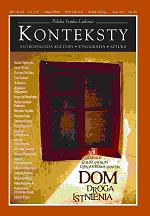Dom – muzeum. Muzeum – Dom
Home–Museum, Museum–Home
Author(s): Katarzyna BarańskaSubject(s): Anthropology
Published by: Instytut Sztuki Polskiej Akademii Nauk
Keywords: anthropology; home
Summary/Abstract: The text commences by focusing on the ostensible contradiction of two concepts – the home and the museum, and goes on to discuss the domains in which these two conceits are connected. First, attention should be drawn to historical relations – collections constituting the beginnings of European museums were created at home and were to serve predominan- tly its residents. After all, private collections are esta- blished up to this day. At times, they comprise, simi- larly as in the initial period of setting them up, an expression of the interest of the author and an invest- ment of capital, and convey the process of building the prestige and self-presentation of the owner or his family. They are also – or primarily – the carriers of private memory, storing objects of economic and sen- timental value. The same holds true for local mu- seums, where souvenirs of the past, of value for socie- ty as awhole, are deposited. Is it possible, therefore, to formulate athesis claiming that alocal museum co- uld fulfil the function of a'family home'? One could indicate an area where the concepts of the home and the museum meet, i. e. museums that feature residen- tial interiors, either apart or awhole. There are seve- ral main types of such institutions. The text considers museums-preserved residences of concrete persons (e. g. the Zamoyski Palace in Kozłówka, the Tumidajski manor house in Dołęga), reconstructions of interiors ascribed to renowned representatives of the world of culture or science, whose memory is preserved by set- ting up abiographical museum. The examples of the Matejko Home in Cracow and the Manor in Czarno- las – the Jan Kochanowski Museum – serve to discuss the main exposition errors, which consist of creating spaces that are aprojection of the imagination and knowledge of museum experts. Asimilar interpreta- tion may be applied in the case of the third type of museums, depicting a'typical interior' from agiven epoch or region (the Hipolit town house in Cracow). The creation of museum reconstructions is deeply embedded in history and the topic of theoretical re- flections. That which appears to be the most relevant is such afulfilment of the expectations of the visitors, which would not violate historical truth and good ta- ste and, first and foremost, would protect the original values contained in the displayed exhibits.
Journal: Konteksty
- Issue Year: 2010
- Issue No: 02-03
- Page Range: 214-220
- Page Count: 7
- Language: Polish
- Content File-PDF

